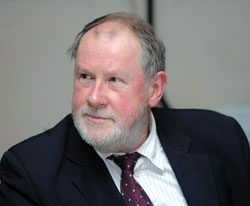|
|
David Seddon is the author of Nepal in Crisis. This Wednesday in Kathmandu he presented a discussion of the same name, examining ways for Nepal to move forward politically.
What were the signs you saw back in the 1970s when you wrote Nepal in Crisis (with Piers Blakie) that convinced you that the country was heading towards a crisis?
We saw a contradiction between a political system which was essentially top-down and constraining and the kinds of struggle that ordinary people faced in maintaining their own survival and livelihoods. It was a country where individual initiatives were not effectively rewarded, and a society with deep structures of discrimination, and hence very difficult for ordinary people to live and improve their lives.
At that time did you feel these conditions were leading towards a political confrontation?
No, I think our notion of crisis back then was not a political crisis. We saw it more as an economic and social crisis that the economy was not developing, and the level of inequality was such that Nepal would fail to resolve its problems. But we didn't foresee a political crisis at that time. In a later book called Nepal: A State of Poverty, which I wrote in the early 1980s I did begin to identify the beginnings of a movement which actually materialised in the Jana Andolan in 1990. By that time it was becoming more evident that politically the situation was unsustainable, but this realisation came gradually.
Have any of these underlying socio-political roots been addressed?
No. I think that there are underlying problems which remain: deep social inequalities and discrimination, the lack of effective representation of ordinary people. There have been certain changes. The Jana Andolan in 1990 did bring about a revival of party politics, but by the mid 1990s the hopes many people had of the parties delivering were fading and I think that gave rise to a feeling of despair, and the Communist Party of Nepal (Maoist) began to think increasingly that armed struggle was the only way in which a major transformation would take place. There are at the moment the beginnings of a political will to address Nepal's social problems, but whether the current parties and leadership have the vision and the ability to transform the political framework remains doubtful.
So there has been no progress at all?
It has been uneven. Much of the hope of 1990 was squandered, and from where I stand one has to blame the politicians, particularly the Nepali Congress politicians who were in power in the early 1990s. There was a failure to really empower the people. Many social inequalities and injustices still remain, and are not fully addressed. The caste system gives religious justification to inequality and castigates lower castes as impure. There is also in many areas a semi-feudal society with large landowners, and tenants and serfs. So as long as those relationships remain, the creativity and energy of ordinary Nepali people will go merely into survival and not into changing things.
Do you think the human and physical cost of the Maoist revolution outweighed the gains?
I don't personally. I am not absolutely convinced that an armed struggle was necessary, but as I said the structural constraints on transforming Nepal are deep and lasting, and I think a major trust for transformation was required. The costs and human suffering have been very serious, but it did bring on to the agenda the issues of social inequality and the lack of political representation, and it enhanced the position of women, dalits and traditionally excluded ethnic minorities. It also alerted people inside and outside Nepal to the need for change. Now that the Maoists are returning to mainstream politics we can be optimistic, if the polls are free and fair, about the possibility of a new political era. But the structural transformation that's required remains to be achieved. If you can call a radical transformation a revolution, then a revolution is needed.



